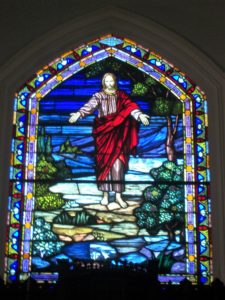
Altar Window
“Come unto me, all who labor and are heavy laden, and I will give you rest.” Matthew 11:28-30
The stained glass window above the altar is a copy of Thorvaldsen’s “The Christus.” Thorvaldsen, a Danish sculptor (1777-1844) portrayed Christ as he appeared to his disciples after his resurrection, greeting them with “Peace be unto you!” The face of Christ is expressive of love and mercy and peace. Christ with outstretched arms also invites all who are troubled and under the stress and strain of the problems of life: “Come unto me, all who labor and are heavy laden, and I will give you rest.”
Balcony Window
“Behold, I stand at the door and knock.” Revelations 3:20
The window in the balcony is probably copied from Holman Hunt’s “The Light of the World.” The scripture which readily comes to mind is, “Behold, I stand at the door and knock: If any man hear my voice and open the door, I will come in to him, and will sup with him, and he with me.” Hunt’s painting shows Christ holding a lantern, which is missing in our window. One can readily understand from Christ’s face and the light above his head, however, that he is truly “the light of the world,” but we must let him in to enlighten our lives. The picture is a call to decision.
Side Windows of Balcony
The pair of windows around Jesus at the Door frame the story of Jesus’ life and death. Particularly in the center of both, are framed images of Jesus’ birth in Bethlehem and his death with the Crosses of Calvary. In many frames of the windows are symbols of his birth and death that are rather special, so take a trip up the stairs to see them for yourself!
Small Details of the Windows
In all the windows, there are intricate designs coming from the Art Deco era but presented in an ancient way. This can particularly be seen with the geometric and color patterns framing each window. Also, in each set of windows, there are smaller church symbols spread throughout the windows. See if you can find them all in your next time with us!
Nave Windows
Each of the six windows on the sides of the nave represents one of the twelve disciples.
- St Andrew: Crossed fish indicates his original occupation was a fisherman. Fisherman’s net represents his call to be a “fisher of men.” Cross and boat hook reminds us that Andrew died on a cross, according to tradition. Pilgrim’s staff and sword crossed means Andrew travelled with the Gospel message.
- St. Peter: Two large keys saltire (crossed) are symbols of Peter’s confession and keys to the Kingdom here on earth. (Matthew 16:19) Inverted cross is the type of cross on which Peter died.
- St. John: John is seated on a stone tomb wearing a bishop’s mitre, right hand raised in benediction, and left hand holding cross-crowned orb. Serpent rising out of chalice represents an attempt to kill John by giving him a poisoned chalice. Eagle rising out of a cauldron of boiling oil represents another attempt on his life. Serpent and sword are indicative of man’s sin and the power of the sword of the spirit over sin.
- St. James, The Greater: Pilgrim’s staff and wallet mean that James traveled extensively preaching. Shells were used to scoop water for drinking. Pilgrim’s staff and Tau Cross show that he suffered death at the hands of Herod. (Acts 12:2) Cross-hilted sword and shell symbolize pilgrimage and martyrdom.
- St. Bartholomew: Open Bible and knife represent faith in God and martyrdom. Three flaying knives remind us that he was skinned alive, decapitated, and crucified. Branch of fig tree tells us of how Jesus first saw Bartholomew. (John 1:48)
- St. Philip: Spear and Patriarchal Cross (two cross bars) represent Philip’s martyrdom. Basket and Tau Cross: The basket tells the story of the feeding of the 5,000 (John 6:7); the Tau cross is the oldest form of cross and gets its name from the Greek letter, Tau.
- St. Thomas: Carpenter’s square, spear and arrows means he built a church with his own hands and was killed by spear, arrows, and three stones. Carpenter square and spear remind us that he built a church and was slain by spear according to tradition. Spears, arrows and three stones represent his death by being stoned, shot with arrows and speared by a pagan priest, according to tradition.
- St. Matthew: Three money bags indicate Matthew was a tax collector. Iron-bound money chest remind us of his former occupation. Battle ax and cross represent his crucifixion on a Tau cross and severed head by halberd or battle axe in Ethiopia, according to tradition.
- St. Jude: Sail boat with cross-shaped mast symbolizes the mission voyages he made for Christ. Knotted club represents his martyrdom. Inverted cross and lance are additional symbols of martyrdom. Carpenter square and boat hook remind us of his occupation.
- St. James, The Less: Windmill show that he was a well-digger by trade. Saw symbolized his death by being thrown from pinnacle and body sawed in pieces. Three stones represent his stoning by Jews. Fuller’s Bat indicates his manner of death by his brains bashed out, according to tradition.
- St. Simon: Saw, oar, and battle ax represent his occupation and martyrdom. Fish on a hook shows he was a Fisher of Men through the Gospel.
- St. Matthias: Open Bible and double battle ax remind us he took the place of Judas. Lance and three stones indicate he was stoned, beheaded and lanced.
Mother’s Window (Jesus with the Little Children)
Jesus said, “Let the little children come to me, and do not hinder them, for the kingdom of heaven belongs to such as these.” Matthew 19:14
This window was originally in the back side section of the Narthex (entrance area). That small area that is now open had once served as a pastor’s office and then as a Mother’s Room/Nursery. This window would have greeted all the young children of the congregation for generations. During the construction of the connecting corridor, the Mother’s window was moved to the central part of the hall.
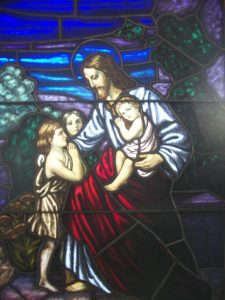


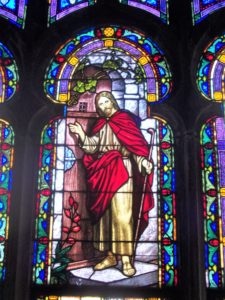
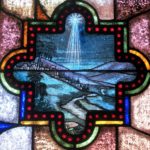
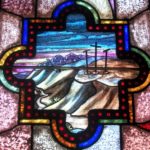
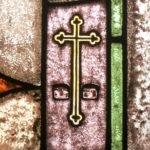
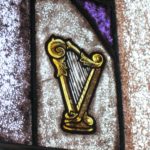
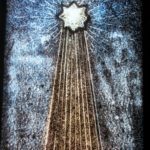
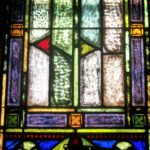
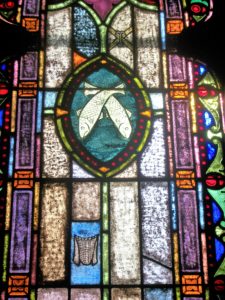
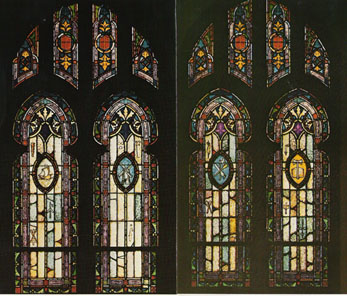
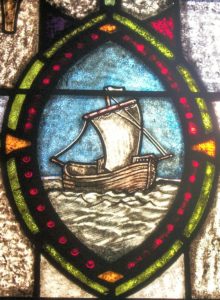
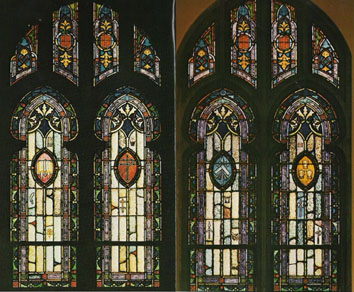
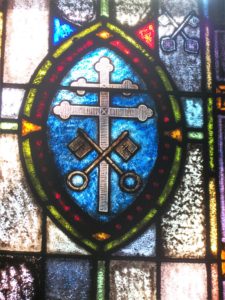
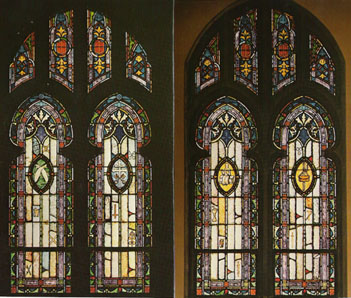
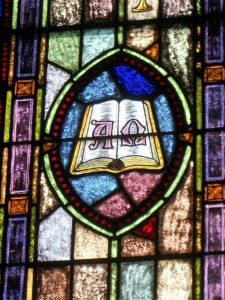
Ways to Follow Us…